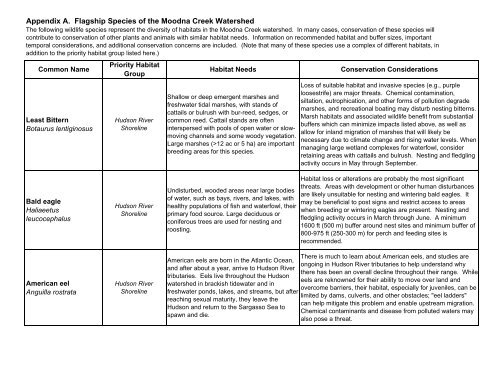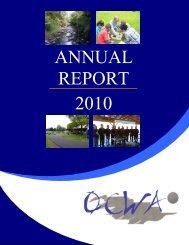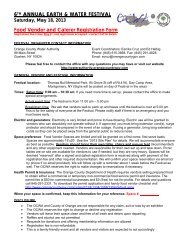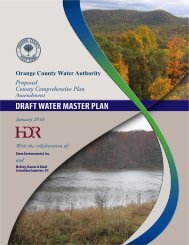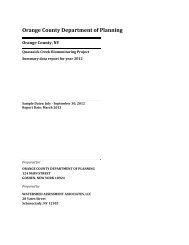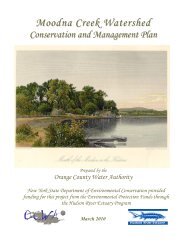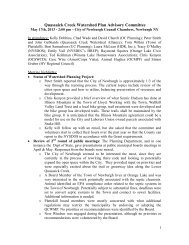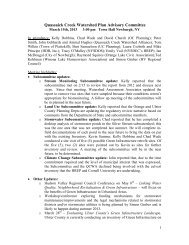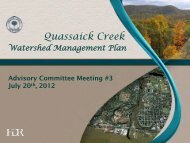Biodiversity of the Moodna Creek Watershed - Orange County Water ...
Biodiversity of the Moodna Creek Watershed - Orange County Water ...
Biodiversity of the Moodna Creek Watershed - Orange County Water ...
You also want an ePaper? Increase the reach of your titles
YUMPU automatically turns print PDFs into web optimized ePapers that Google loves.
Appendix A. Flagship Species <strong>of</strong> <strong>the</strong> <strong>Moodna</strong> <strong>Creek</strong> <strong><strong>Water</strong>shed</strong><br />
The following wildlife species represent <strong>the</strong> diversity <strong>of</strong> habitats in <strong>the</strong> <strong>Moodna</strong> <strong>Creek</strong> watershed. In many cases, conservation <strong>of</strong> <strong>the</strong>se species will<br />
contribute to conservation <strong>of</strong> o<strong>the</strong>r plants and animals with similar habitat needs. Information on recommended habitat and buffer sizes, important<br />
temporal considerations, and additional conservation concerns are included. (Note that many <strong>of</strong> <strong>the</strong>se species use a complex <strong>of</strong> different habitats, in<br />
addition to <strong>the</strong> priority habitat group listed here.)<br />
Common Name<br />
Least Bittern<br />
Botaurus lentiginosus<br />
Priority Habitat<br />
Group<br />
Hudson River<br />
Shoreline<br />
Habitat Needs<br />
Shallow or deep emergent marshes and<br />
freshwater tidal marshes, with stands <strong>of</strong><br />
cattails or bulrush with bur-reed, sedges, or<br />
common reed. Cattail stands are <strong>of</strong>ten<br />
interspersed with pools <strong>of</strong> open water or slowmoving<br />
channels and some woody vegetation.<br />
Large marshes (>12 ac or 5 ha) are important<br />
breeding areas for this species.<br />
Conservation Considerations<br />
Loss <strong>of</strong> suitable habitat and invasive species (e.g., purple<br />
loosestrife) are major threats. Chemical contamination,<br />
siltation, eutrophication, and o<strong>the</strong>r forms <strong>of</strong> pollution degrade<br />
marshes, and recreational boating may disturb nesting bitterns.<br />
Marsh habitats and associated wildlife benefit from substantial<br />
buffers which can minimize impacts listed above, as well as<br />
allow for inland migration <strong>of</strong> marshes that will likely be<br />
necessary due to climate change and rising water levels. When<br />
managing large wetland complexes for waterfowl, consider<br />
retaining areas with cattails and bulrush. Nesting and fledgling<br />
activity occurs in May through September.<br />
Bald eagle<br />
Haliaeetus<br />
leucocephalus<br />
American eel<br />
Anguilla rostrata<br />
Hudson River<br />
Shoreline<br />
Hudson River<br />
Shoreline<br />
Undisturbed, wooded areas near large bodies<br />
<strong>of</strong> water, such as bays, rivers, and lakes, with<br />
healthy populations <strong>of</strong> fish and waterfowl, <strong>the</strong>ir<br />
primary food source. Large deciduous or<br />
coniferous trees are used for nesting and<br />
roosting.<br />
Habitat loss or alterations are probably <strong>the</strong> most significant<br />
threats. Areas with development or o<strong>the</strong>r human disturbances<br />
are likely unsuitable for nesting and wintering bald eagles. It<br />
may be beneficial to post signs and restrict access to areas<br />
when breeding or wintering eagles are present. Nesting and<br />
fledgling activity occurs in March through June. A minimum<br />
1600 ft (500 m) buffer around nest sites and minimum buffer <strong>of</strong><br />
800-975 ft (250-300 m) for perch and feeding sites is<br />
recommended.<br />
There is much to learn about American eels, and studies are<br />
American eels are born in <strong>the</strong> Atlantic Ocean,<br />
ongoing in Hudson River tributaries to help understand why<br />
and after about a year, arrive to Hudson River<br />
<strong>the</strong>re has been an overall decline throughout <strong>the</strong>ir range. While<br />
tributaries. Eels live throughout <strong>the</strong> Hudson<br />
eels are reknowned for <strong>the</strong>ir ability to move over land and<br />
watershed in brackish tidewater and in<br />
overcome barriers, <strong>the</strong>ir habitat, especially for juveniles, can be<br />
freshwater ponds, lakes, and streams, but after<br />
limited by dams, culverts, and o<strong>the</strong>r obstacles; "eel ladders"<br />
reaching sexual maturity, <strong>the</strong>y leave <strong>the</strong><br />
can help mitigate this problem and enable upstream migration.<br />
Hudson and return to <strong>the</strong> Sargasso Sea to<br />
Chemical contaminants and disease from polluted waters may<br />
spawn and die.<br />
also pose a threat.


